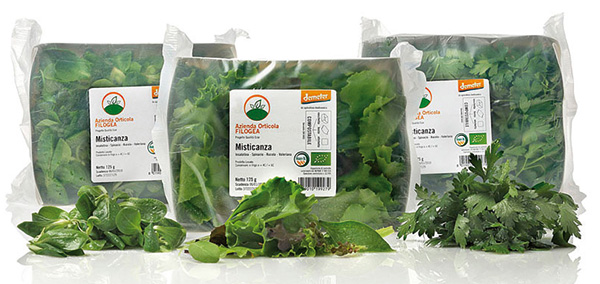Bioplastics
Market and packaging: facts and potential.

Bioplastics possess the characteristic of completely decomposing in relatively little time (from a few months to a year at most), in contrast to conventional plastics, whose degradation process is extremely slow.
In a market that is increasingly attentive to environmental concerns, the development potential of these polymers is nearly limitless. Nonetheless, according to Assobioplastiche, we are still far from having explored their full potential. Less than 0.5% of plastic products are made using bioplastics (as of 2015).
The uses of this material are many. The sector is currently being driven by shopping bags and the bags used in the home for separate disposal of compost.
Shopping bags. After the ban on the sale of conventional plastic shopping bags went into effect in January 2011, the number of bioplastic shoppers has increased exponentially.
According to Istituto Italiano Imballaggio, approximately 112,000 t of plastic shoppers (conventional and biodegradable) were used for grocery shopping in 2015. The product has been in sharp decline (-25%) since 2010, when consumers began using reusable cloth or plastic bags with increasing frequency.
Also according to Istituto Italiano Imballaggio estimates, some 36% of plastic shoppers are now made using bioplastics (40,300 t).
Containers. Also for the packaging sector, bioplastics are used to produce tubs, preforms for bottles, coffee pods, foodsafe films (for pasta and cheeses) and non-food products (electric components).
The current situation and projections
According to Plastic Consult*, 54,500 t of bioplastics were produced in Italy in 2015, 73% of which went to shoppers (39,785 t). While in 2013 the share was 65%, 2016 is expected to bring another drop of 10% or so. Compostable bags are expected to lose a lot of ground as PE is taken up again. This trend is supposed to be partly due to the lack of enforcement of administrative sanctions introduced with the January 2011 regulation. Almost certain, moreover, is the increased use of reusable PE shoppers.
Bioplastics are also used in the manufacture of other product types: 16% go to compost disposal bags, 5% to film, 3% to disposable items like cutlery and cups, 3% to other applications, including preforms and tubs, but also stationery.
TO BE CLEAR
«The term “bioplastic” refers to those materials and products that have the characteristic of being biodegradable and compostable, whether they originate from renewable or from fossil sources.
The concept of bioplastic therefore applies to products that, at the end of their life cycle, guarantee organic recyclability, certified for each environment (composting, anaerobic digestion and soil). The use of renewable sources, ideally derived from industrial byproducts and wastage, is an important factor but does not constitute per se bioplastic material.
In fact, it is also possible to employ renewable raw materials in the production of conventional polymers, for example so-called “green polyethylene”, which at the end of its life cycle behaves like fossil-derived PE but presents no biodegradability or compostability properties. Such products are referred to as “plant-based plastics” in order to avoid their being confused with bioplastics».
Fonte: AssoBioplastiche
* Plastic Consult is a private, independent firm offering consulting services and conducting market research in the plastics sector and manufacturing generally since 1979.
Plinio Iascone
Istituto Italiano Imballaggio

















